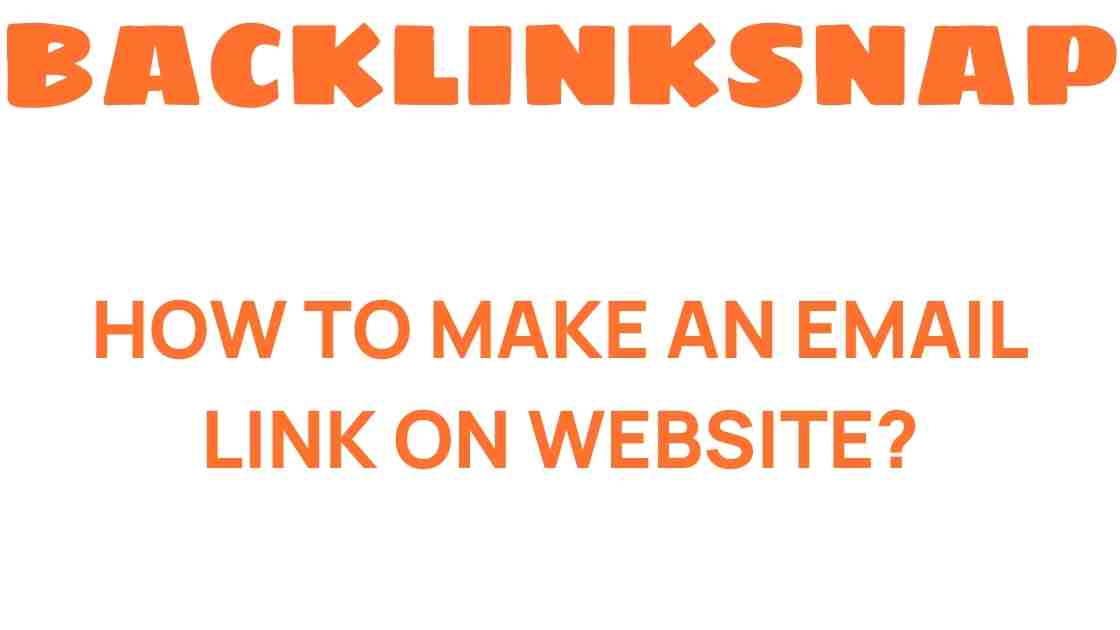Unlocking the Secret: How to Make an Email Link on Your Website
In the vast digital landscape, effective communication is crucial for any successful website. One of the simplest yet most effective ways to facilitate this communication is by creating an email link. Whether you’re running a personal blog, an e-commerce site, or a corporate portal, having a functional email hyperlink can significantly enhance user engagement and streamline contact processes. In this article, we’ll explore how to create an email link using HTML, the benefits of having one, and best practices for web design and digital marketing.
Understanding Email Links
An email link is a hyperlink that, when clicked, opens the user’s default email client with a new message addressed to a specified email address. This simple feature can dramatically improve user experience by making it easier for visitors to reach out to you or your business. In the context of digital marketing, an effective email link can encourage more inquiries, feedback, and overall engagement.
How to Create an Email Link Using HTML
Creating an email link on your website is straightforward, even for those who may not consider themselves tech-savvy. Below are the steps to craft your own email hyperlink:
- Step 1: Open your HTML editor or the platform where you edit your website’s code.
- Step 2: Use the following basic HTML structure for your email link:
<a href="mailto:youremail@example.com">Contact Us</a>- Step 3: Replace “youremail@example.com” with your actual email address.
- Step 4: Customize the link text “Contact Us” to whatever you prefer, such as “Get in Touch” or “Email Us.”
Here’s an example of how it looks in practice:
<a href="mailto:info@yourwebsite.com">Email Us</a>When users click on this link, their default email client will pop up with a new email addressed to info@yourwebsite.com.
Enhancing Your Email Link with Additional Features
While a basic email link is functional, you can enhance it with additional features to improve user experience:
- Subject Line: You can pre-fill the subject line of the email by adding “?subject=Your Subject Here” to the link. For example:
<a href="mailto:info@yourwebsite.com?subject=Inquiry">Email Us</a>- Body Text: Similarly, you can pre-fill the email body. Add “&body=Your message here” after the subject:
<a href="mailto:info@yourwebsite.com?subject=Inquiry&body=Hello, I would like to know more about...">Email Us</a>This not only saves time for users but also encourages more structured communication.
Why Email Links are Essential for Your Website
In the world of web design, every detail counts, including how you facilitate communication. Here are several reasons why including an email link on your website is vital:
- Improved User Engagement: An easy-to-find email link encourages visitors to connect, ask questions, or provide feedback, enhancing overall engagement.
- Professionalism: A dedicated contact method enhances your brand’s credibility, showing that you care about communication.
- Convenience: Users appreciate the simplicity of being able to click a link rather than copying and pasting your email address.
- Increased Conversion Rates: In digital marketing, every interaction counts. More inquiries can lead to higher conversion rates.
Best Practices for Using Email Links
While creating an email link is simple, following best practices ensures that you maximize its effectiveness:
- Make It Visible: Ensure your email link is prominently displayed on your website, ideally on the contact page or in the footer.
- Use Call-to-Action Buttons: Instead of plain text links, consider using buttons to draw attention. This can significantly increase click-through rates.
- Test the Link: Always test your email link to ensure it directs to the correct email address and functions properly.
- Monitor Engagement: Use tools to track how often users are clicking your email link, which can provide insights into user engagement.
FAQs About Creating Email Links
1. What is an email link?
An email link is a hyperlink that opens a user’s default email program to send an email to a specified address.
2. How do I create an email link in HTML?
Use the format <a href="mailto:youremail@example.com">Your Link Text</a> in your HTML code.
3. Can I pre-fill the subject line of an email link?
Yes, by adding ?subject=Your Subject to the end of your email link, you can pre-fill the subject line.
4. Should I use email links on all pages?
It’s best to include email links on key pages such as contact pages, service details, and the footer of your website for easy access.
5. Are there any downsides to using email links?
One potential downside is that email links may expose your email address to spam bots. Consider using forms for contact as an alternative.
6. How can I ensure my email link is effective?
Make it visible, use clear call-to-action buttons, and regularly monitor user engagement to ensure effectiveness.
Conclusion
Creating an email link on your website is a small yet powerful step toward enhancing user engagement and facilitating communication. By following the steps outlined in this article, you can easily implement email hyperlinks that not only serve a functional purpose but also bolster your brand’s professionalism and credibility. Remember, in the realm of digital marketing and web design, effective communication is key. So, make it easy for your visitors to reach you and watch your engagement soar!
For more on improving your website’s communication tools, check out our guide on best practices for contact forms.
For further insights into digital marketing, visit Digital Marketing Trends.
This article is in the category Digital Marketing and created by BacklinkSnap Team





Discover Which Ticket Website Has the Lowest Fees for Your Next Event
April 13, 2025[…] are fees added by the ticketing platform for handling your purchase. They can vary widely from one website to […]